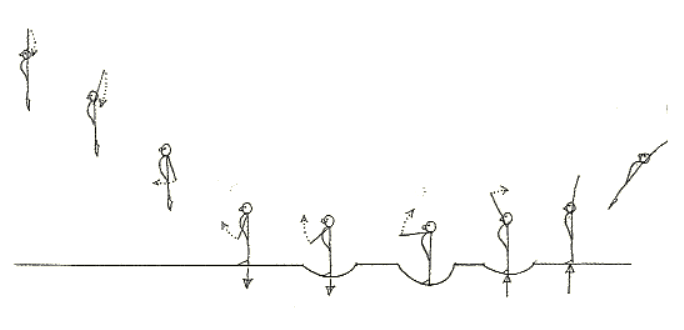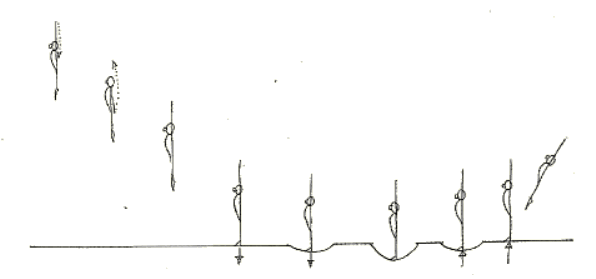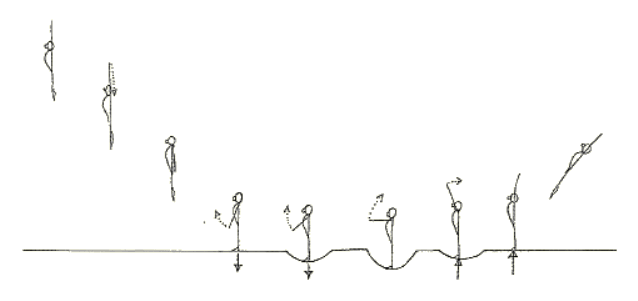The Technique of 'Arm Setting' - part 2
In the last issue of GymCraft I discussed the evolution of the ‘arm set technique, highlighted its advantage when taking off for forward somersaults and recommended a method of teaching it. This time I want to open up the subject and show that it is not simply a method of getting the performers arms overhead for take off.
In order to benefit fully from what follows, you are recommended to read my first article for this publication “A Fresh Look at Take Offs.” The main point I made on that occasion was that “it ain’t what you do it’s the time that you do it, that’s what gets results!” All actions made by the trampolinist whilst in contact with the bed have to be in time with its depression and recoil otherwise inferior performance occurs. I emphasized that there is no such thing as a take off or a landing but a “take off phase” and a “landing phase.” There is a distinct time lapse between touch down and the bed reaching full depression as well as between full depression and the moment of release and this must be clearly understood by coach and performer alike.
The timing of the “arm set” action in relation to these phases must therefore be studied and understood so that the technique can be used to the advantage of the performer. From my discussions with coaches, particularly at the middle competitive levels, it appears that an “arm set” is being used in imitation of the many top performers who use it and this is done blindly without any thought or understanding. Several coaches have told me that they teach it to their competitors because the judges deduct marks if it is not used! Others confer magical powers on the technique, even that it prevents the performer from travelling. Whilst I can not be sure what individual judges do, the only guidance they should follow is that the arms should be straight whenever possible and this can be achieved either with an “arm set” or a “natural” arm swing. The belief that an “arm set” prevents travel in backward somersaults is preposterous since there is only one cause of travel; leaning off balance during the take off phase! The ability of the gymnast to maintain balance and good posture during the take off phase is what matters, regardless of the style of arm action used.
In the last edition I recommended the “arm set” primarily for forward take offs because of the real advantage of initiating forward skills with the arms over head. I did not dismiss its use for backward take offs but this area is more controversial and if the technique is mistimed it can be more hindrance than help for the trampolinist. The following analysis focuses particularly on backward take offs. It is important to note that whatever arm action is employed in generating somersaults from straight jumping, the downward path of the arms must remain within the envelope of the body. Please note that in the diagrams which follow, the arms are shown as descending just behind the body line for ease of illustration.
Categories of Arm Action for Somersault Take Offs from Straight Jumping
I believe we can identify three categories of arm action. (The categories and names are my own and not necessarily generally recognized as such).
- Natural Arm Swing
- Early Arm Set
- The Late Arm Set:
- Late Swinging Arm Set
- Late Dynamic Arm Set
1. The Natural Arm Swing
This, as the name suggests, is simply a continuation of the basic backward circling action used in straight jumping. I have already dismissed this for all forward somersault take offs although a case can be made for its use in setting up skills like front drop and crash dive, where it is desirable to limit the amount of rotational force during take off. If it is used for initiating backward rotations it has the built in advantage that the arms are already rotating in the direction of the somersault. Younger light weight trampolinists however do not spend enough time with the bed depressed in order to finish the arm swing directly overhead. Mature performers experience no such difficulty and provided they maintain good core stability throughout landing and take off phases they can benefit greatly from the additional rotational contribution of the arm swing. Coaches using this technique with younger pupils should invite their charges to swing and stop the arms at shoulder height, gradually developing a higher finishing point as maturity, weight and strength increases over the years. Despite the logical direction of the movement the action must, of course, be correctly timed for best effect. The arms should be rising forward and up as the bed is going down thus encouraging further depression and, as the bed returns, the continuing upward arm swing will act against the bed which has now become as hard as the floor. This latter part of the arm swing can contribute a significant rotational input but as ever the secret of success is the precise timing in relation to the landing and take off phases (Fig 1).

Fig 1
2. The Early Arm Set
This is the most widely used and in my view the least effective, but many coaches are unaware that different timing is available since they have simply been trying to copy what they have seen. Fig 2 offers a diagrammatic view of a typical early arm set.

Fig 2
It can be seen that the arms are overhead for a long time prior to the gymnast making the initial contact with the bed. I believe this to be premature, hence I have tagged the timing early. Of course it has the advantage of preparing the arms overhead for forward rotations but this is offset by the risk caused by having the arms overhead for so long during the falling time as well as throughout bed depression time. The slightest fluctuation in balance during the landing and take off phases has to be dealt with while the arms are high overhead, putting an unacceptable strain on the performer’s back. Dealing with minor balance problems in the bed is, of course, one of the roles of the stabilising muscles but the high position of the arms makes their job all the harder. I can’t recall ever seeing a tightrope walker attempt to walk the wire with their arms in such a position! Having made this point let me turn to the use of the early arm set when producing a backward somersault. I would argue that it has significant technical limitations. The take off phase for a backward somersault starts when the bed is totally depressed and if the arms are fully overhead at this point they are effectively taken out of use. They can not assist with minor balance adjustments and can contribute nothing to the rotational force required. The one advantage I can see is that when the gymnast is in the early flight phase with the arms still overhead, a dramatic acceleration can be achieved as they are brought down into the required form shape.
In my previous article, I described how I would use the tuck jump to teach an arm set but, if the reader refers back to the drawing illustrating the method, it can be seen that an early arm set is in fact produced. Before I get accused of double standards let me emphasise that this method should only be used to establish the pattern and rhythm of the technique. Once the leg bend has been eliminated from the tuck jump and there is a competent and controlled touch down and lift of the arms, coaches should start working to delay the arm drop so that one of the late arm sets is evolved.
3. The Late Arm Set
As can be seen from figure 3 the difference between this and the early arm set is a longer delay before touching the arms down to the sides of the body. Furthermore the arms remain at the sides on the final part of the descent to the bed.

Fig 3
The first benefit with this variation in timing is that as the bed is initially contacted (the start of the landing phase) the arms are not overhead but on their way forward and upwards, giving greater stability at a time when minor fluctuations in balance may have to be dealt with. As the bed is depressed the arms continue on their upward and backward rotating path thus adding to the depression to the bed. As the bed is fully depressed (the end of the landing phase and beginning of the take off phase) the arms have not yet swung fully overhead and as the bed rises, making it into a solid surface to work against, the arms can complete their swing directly overhead adding to the turning force required for creating the backward somersault. The performer now leaves the bed with the arms overhead giving the opportunity to create acceleration in flight by bringing the arms down into the form position. It can be seen that there are far more benefits to be obtained from this than from the early arm set and the risk of stress on the back is minimised. The above description covers both the “swinging” and the “dynamic” versions of the late arm set and I will now highlight the difference between the two.
3 (a) The Late Swinging Arm Set
In this variation the path and timing of the movements is as described but the emphasis is on a smooth pendulum action flowing logically with the fall and rise of the bed.
3 (b) The Late Dynamic Arm Set
Here the emphasis is on a fast, powerful arm lift starting at the moment the bed is first contacted, the theory being that this action causes a marked increase in bed depression. This should in turn enable the performer to generate more power from the bed which can be harnessed, either as additional “top” on the somersault, or greater turning force, depending on the posture employed during the recoil. My view is that this technique should only be employed by gymnasts with the strength to maintain the desired posture as the additional recoil is obtained, otherwise snatching, sitting or killing of the take off may result.
Well there you have it. Pay your money and make your choice but be aware of what you are trying to achieve. Work to understand the significance of these subtle differences on the performance of your trampolinists. Whatever you do, on no account buy into the mythology of trampolining which attributes magical powers to certain arm actions.
© Jack Kelly
 ®
®









